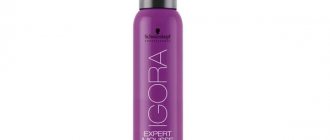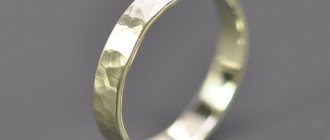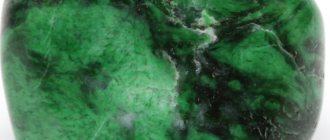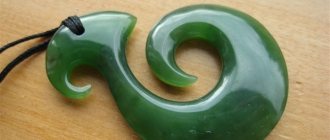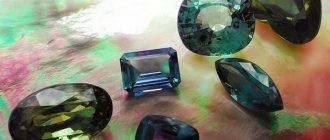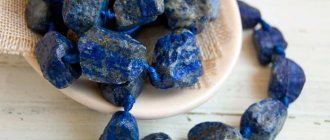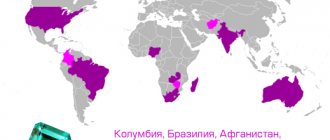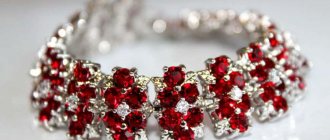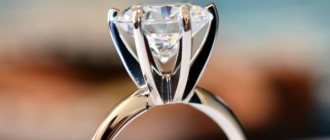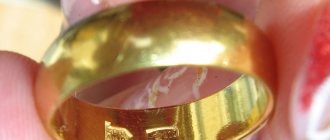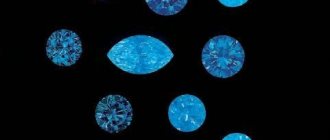Nephritis got its name from the Greek “nephros” - “kidney”. Inflammatory kidney disease has the same name, which is why, trying to find out how pyelonephritis differs from nephritis, people often become acquainted with a previously unknown mineral with healing properties. The ancients believed that jade copes with inflammation that occurs with kidney disease and helps relieve renal colic.
The high price of a jade product is the reason for the appearance of a large number of fakes and artificially synthesized stones. Jade treatment is effective only if the stone is genuine and has not lost its qualities during processing.
Color range of natural jade
The stone is common. Shades of green are familiar to him.
However, rarer and more valuable varieties may come in other colors, such as:
- white (yellowish-white, white-gray, waxy and milky white);
- honey (opaque, all shades of honey);
- gray (grayish green);
- yellow (lemon to brownish, yellowish with milky areas, greenish-yellow);
- blue, light blue (found in Yakutia);
- red (one of the rarest and most expensive);
- black.
Jade is characterized by green shades.
There are stones of a special structure, which gives the jade a “cat’s eye” effect.
All other shades (purple, etc.) indicate an outright fake. And the rarer the color of the jade, the higher the risk of running into it.
Characteristics of the mineral
Jade belongs to the group of amphiboles and the class of silicates, chemical formula: NaAl(Si2O6). In addition to green, it comes in black, gray, white, brown and blue. Transparency ranges from translucent to completely opaque. It has a density in the range of 2.8–3.3 g/cm3, a hardness of about 6 according to Mohs and a refractive index of 1.6–1.65. The largest jade was discovered in 1960 in China, had a smallest side of four meters, and the largest - almost eight and weighed 260 tons.
There is a misconception that the color of jade is only green. In fact, this stone has many colors and shades:
- Light green, this stone is colored unevenly, and the tint can be yellowish or bluish.
- Bright green, the color is saturated, but the color itself is uneven.
- Rich green.
- Gray-green, patterned and spotted.
- Greenish-gray.
- Swampy with streaks of brown.
- Black color.
- White color can have several shades: bluish, grayish - pure white does not exist. The color structure is uniform.
- Emerald green, "imperial", one of the most valuable species.
- Blue jade.
- Red color is the rarest.
- Brown and tan.
White jade. This stone is valued for its attractive appearance and high strength. It is believed that such a stone has magical powers. People believe that it is able to clear thoughts of negativity and strengthen strength and spirit. It improves logical thinking and affects mental abilities.
Green jade. If you look at such a stone for a long time and at its unusual lines created by nature itself, then calm and tranquility comes. The stone helps to discover talents and find yourself. If you wear the stone around your neck for a while, it can help you realize your purpose in life.
Black jade is very often used in jewelry; it is also used to create interior items. Black jade looks mysterious and unusual. Depending on the color, it can have a different structure, uniform or spotted. There is also a spotted-disseminated structure of black jade.
Homogeneous jade of this color is highly translucent. The rest includes minerals such as magnetites, chlorites, iron and others. Thanks to them, patterns are created on the surface. Used for making jewelry, boxes, facing material, vases, pyramids and more.
Terrible events are associated with black jade. In the Middle Ages, it was believed that the border of the underworld was made of black jade, since this material has high strength. That is why the tombstone of the cruel ruler of those times, the conqueror Timur, was made of black jade.
In the 18th century, the Shah of Iran transported this tombstone to Persia. As soon as the plate crossed the border of Iran, a terrible earthquake occurred there. After the return of the Shah and another earthquake, the stone was returned to its place.
What is fake jade made from?
Everything that is offered on the jade market can be divided into several groups:
- stones that have not been subjected to any influence other than artistic or jewelry processing;
- nondescript or low-quality natural minerals that have been specially treated to make them more attractive.
Refinement methods can be:
- physical, which change the entire structure of the stone (irradiation, exposure to high temperatures and pressure);
- chemical (impregnation with compounds that increase transparency, or coloring, which is washed out over time, sometimes varnishing).
Fakes are:
- pressed production waste from natural minerals;
- cheap natural stones resembling jade;
- pacifiers made of glass and plastic.
Fake jade is made from natural, cheap stones.
Visual recognition methods
The buyer should be wary of too bright unnatural color, graininess, striping, blurring of the boundaries of color segments, excessive transparency and suspicious uniformity.
Shine on the surface
Jade lends itself well to processing and polishing, but with rare exceptions its shine remains muted, matte, oily, silky, greasy, waxy. This is his distinctive feature.
Real jade has a shine on the surface.
Rough plastic fakes have almost no shine, and all other imitations have it too bright to fit the listed definitions.
Pattern and structure
If, with the help of a magnifying glass, and even more so without it, graininess is clearly visible in the product, then it is definitely not jade. Its structure is a mesh of the finest fibers that make up unique patterns. If the fibers are too obvious or patterned, then it is most likely a crude plastic or glass fake.
Jade can be either uniform (rarely) or patterned. The stone patterns are chaotic and unique. Therefore, their similarity on several products raises suspicion.
The color boundaries of a natural mineral are clearly marked, unlike most fakes.
Due to its structure, jade almost does not transmit light (with the exception of thinned edges or plates 1.5-2 cm wide).
Translucency or transparency in all other cases clearly indicates a fake.
Check for mechanical damage
A seller who is confident in the quality of his product and knows how to distinguish jade from a fake willingly demonstrates evidence of the authenticity of the stone. Otherwise, this is a reason for doubt.
It is impossible to spoil natural jade using the methods described below.
Scratching from needles or blades
You can scratch something on the product. If the hardness of such an object is higher than that of the mineral, a mark will remain; if less, the stone will be unharmed. However, you should not scratch the inclusions, which have a different structure and may be damaged.
Fake jade can be scratched with a needle.
The table below will help you preserve your jade product and come to the right conclusions.
Comparative table of hardness on the Mohs scale with permissible deviations of 0.5 in both directions
| Material | Hardness |
| Nephritis | 6 |
| Jadeite, quartz glass, natural quartz | 7 |
| Metal (except aluminum), window glass | 5 |
| Other minerals most often passed off as jade | 4 or less |
That is, a fragment of quartz glass or a piece of quartz will spoil all of the listed minerals, except jadeite. And on the window glass, natural jade itself will leave a mark. A nail, knife, pin, or sewing needle will not harm jade and jadeite, but will scratch other fakes.
However, this method is only suitable for high-quality, hard jades.
Impact strength
High-quality jade is 2 times stronger than steel, which is why in ancient times weapons were made from it. It cannot be broken with a hammer; products made from it remain unharmed when they hit the floor. However, due to its plasticity, when it hits a hard surface, small dents may appear on it.
High-quality jade is stronger than steel.
If the stone still manages to be broken, its fragments will be needle-shaped stone chips.
Test by fire
It is enough to hold the product over the flame for half a minute, and the surface will become smoky. But a black spot on natural jade can be easily wiped off without a trace, unlike a fake. The plastic over the fire will begin to smell burning and melt.
The binder component in the pressed material will not hold up and an unpleasant chemical odor will appear.
It is not recommended to heat the thinned edges of products so that a sharp temperature change does not cause cracks.
Pressed
Natural minerals have always been expensive, be it an animal figurine, a craft, or jewelry.
This is primarily due to the fact that it helps to strengthen the health of its owner, endows him with personal qualities, and helps him cope with emotions. There are many people who want to receive additional help, but not everyone can afford to purchase a natural gem. Therefore, they try to find a product at a lower price. But for some reason no one thinks that a fake is not only useless - it can cause additional harm. Often, instead of real black jade, pressed jade is found in products. How to check the authenticity in this case?
Pressed stone consists of waste after processing of real mineral (fragments, shavings, dust). First they are ground and pressed, and then added to synthetic materials. At the same time, the resulting mixture looks like a natural gem.
On topic: Where is the mineral jade mined and how is it used?
To find out what the craft is made of, you can hold it over the fire for 20–30 seconds (a regular lighter will do). Since plastic is often used to make pressed stone, the product will begin to melt, and you will notice a specific smell. In addition, a dark-colored spot will remain at the point of contact with the fire (although it is hardly noticeable against a black background).
The natural mineral is not subject to deformation from the fire of a lighter , so before you buy the product, ask the seller for permission to test it. Refusal to conduct the experiment will only indicate that they may be trying to sell you a counterfeit product.
Formal signs of fake jade
First of all, this is the seller’s refusal to examine the goods and the lack of a complete package of accompanying documents.
Low cost
First of all, the suspiciously low price for a clearly unusual specimen should alert you. In Russia, the cost of local minerals and products made from them lags behind world prices, but focusing on domestic prices when purchasing goods abroad is a big mistake.
It is primarily influenced by the color of the stone. So 1 kg of blue or red jades can cost up to 10 thousand dollars.
Of the stones suitable for jewelers, the most valuable are white and deep green, the price of which is at least $50 per 1 carat. The cost of a green jade ball is approximately 350-400 rubles, and a white one - from 600 to 1000. And if a bracelet or beads are offered at the price of 1-2 beads, it means that we are talking about a deliberate fake. But scammers may offer fakes at a higher price for credibility reasons.
The price is influenced by many factors, including subjective assessments. But it is useful to compare average prices in Russia and China, where jade has been valued more than gold since ancient times.
Areas of application
Biruni writes:
“They say that jade... is called the stone of victory, and for this reason the Turks, trying to achieve victory in single combat and combat, decorate their swords, saddles and belts with it.”
- Now swords and saddles are irrelevant. Jade crafts are used to decorate houses and apartments, as well as women.
- Bath lovers use jade to obtain light and healthy steam.
Photo comparison of natural stone and fakes
If you photograph the products from the right angle and distance and with the right lighting, then a specialist will be able to distinguish between an item made of natural jade and a fake by its shine and other visual features.
Photo comparison of the original and the fake. Photo comparison of the original and the fake. Photo comparison of the original and the fake. Photo comparison of the original and the fake. Photo comparison of the original and the fake.
